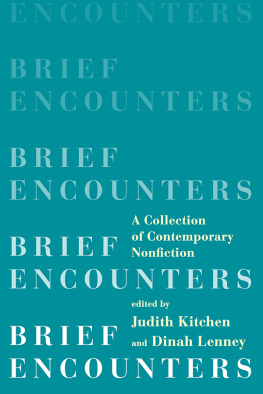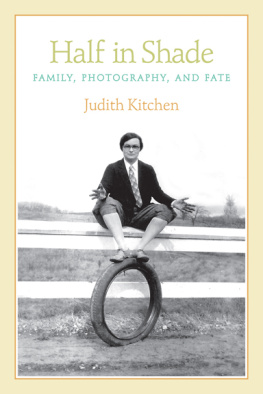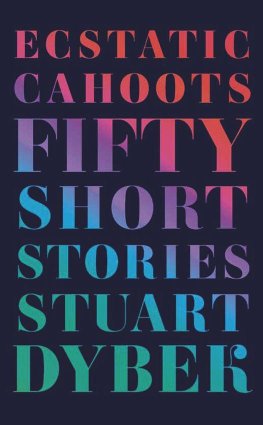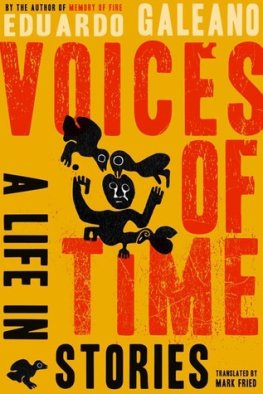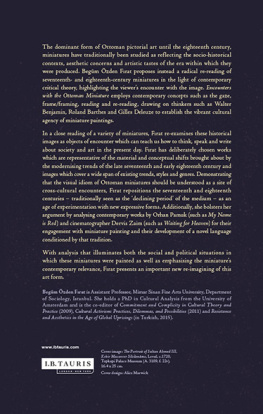
JUDITH KITCHEN
ESSAYS
The Circus Train
Half in Shade
Distance and Direction
Only the Dance
NOVEL
The House on Eccles Road
ANTHOLOGIES
Short Takes
In Brief
In Short
The Poets Guide to the Birds
DINAH LENNEY
MEMOIR AND ESSAYS
Bigger than Life: A Murder, a Memoir
The Object Parade
CRAFT
Acting for Young Actors

Brief Encounters
Copyright 2016 by the Estate of Judith Kitchen
and Dinah Lenney
All rights reserved
First Edition
For information about special discounts for bulk
purchases, please contact W. W. Norton Special Sales
at specialsales@wwnorton.com or 800-233-4830
Book design by Faern de Vicq
Production manager: Louise Mattarelliano
ISBN: 978-0-393-35099-9 (pbk.)
ISBN: 978-0-393-35100-2 (e-book)
W. W. Norton & Company, Inc.
500 Fifth Avenue, New York, N.Y. 10110
www.wwnorton.com
W. W. Norton & Company Ltd.
Castle House, 75/76 Wells Street, London W1T 3QT
Do we want to dedicate this book, and to whom? Ideas?
What color cover jacket would you like?
Judith Kitchen, October 4, 2014
Are you there? Can you hear what I have to
tell you? Our lives are finiteand yet... Look
at the way they preserve themselves.
Judith Kitchen, The Circus Train
For Judith
IVE BEEN THINKING about an exhibit I saw a few years ago at the Metropolitan Museum of Art. Rooms with a View, it was calledand if I hadnt had any other reason to fly across the country, it would have been enough: four galleries, beautifully curated, and each piece (there were more than fifty) featured a window. I loved itloved the idea, loved its executionthe frame within the frame in every single painting, that was why I had to see; that was the hook, the angle that caught and held my imaginationthe possibilities within and beyond the life of each canvas, the narrative opening in ways mysterious and provocative and ongoing, and those ongoing mysteries and provocations essential to its depth and truth. My mother-the-designerwho lives in New York, who had seen the show on her ownhad other ideas: when she and I compared notes, we discovered wed had different experiences, hers perhaps more in line with the curators intentions than mine. The paintings werent about the windows, said she. Theyd been selected for their subject matterfor how each interior evoked the culture of the time, the values and habits of the people who had lived and worked in those rooms. She was right, of course. But so was I. A curator can lead the way, after all; she can even offer a headset and a guided tourbut, Everything that is worthwhile is to some extent subjective, wrote Nabokov in Good Readers and Good Writers, and therefore, deserves a subjective response.
Recently, with this intro in mind, I went back to the New York Times review that caught my eye in the first place, where critic Roberta Smith wrote, The works here determinedly say no to established authoritative statements: formal portraiture and large-scale history painting; under the circumstances, as applied to this collection of prose, how perfectly apt.
Although, as befits the genre (personal essay), Im compelled to confess: I dont actually remember the paintings in order. I couldnt tell you which I saw first, or last, or how they were arranged on the walls. Nor do I suppose that the ones that struck me at the time would strike me today. Maybe some of them would. Undoubtedly others would spark for me as well. What I will insist is that they worked together; something for everyone and each piece worthy in and of itself, of course; but placed side by side, or across from each otherhow this view mirrored that! How these lines, this shading, these curtains, this blue, this figure of a woman, this man in his topcoat, echoed, answered, or resolved an image Id seen only moments before. There were some canvases I came back to again and again, and each time they looked different to me. Because thats how it is with art, or how it should beand also because, as a collection, they engaged to inform each other and my experience of them; and would do so, Im certain, all over again.
Brief Encounters, I hope, is much the same sort of deal. Actually, I wish we could retitle it Meaningful Encounter (singular) or Continuous Encounter (ditto). My point? Think of this book as a gallery: no large-scale portraits or formal histories here, but by virtue of collecting these shorts, we mean to appeal to your readerly desire for resonance and depth.
Therefore I invite you to read the whole thing at once. Read it today, tonight, starting here, starting now, cover to cover. Or no. No, dont do thatlinger, savor, take your time. Revel in each piece (we did)and maybe share the excitement we felt as they began to accumulate; to talk to each other; to commiserate, contradict, enrich, color and shade, take on new properties and dimensions having everything to do with proximity and the way they fell into order.
Collections of anything speak to abiding appreciation as opposed to short attention spans. So we offer this onewhich contains multitudes, by the way: multiple collections within the collection. In some cases weve placed them just so, back to back, as with Glazner and Wilson on sport, or Montemarano and Nadelson on pets. In others weve got them in dialogue on the level of the sentence or the subject: that is, where one writer ends, another begins, as with Cooley and Kothari, Parms and Geyer. Woven all the way through, to keep you situated and as if wed planned it, notions about place and displacementsee Lopate, Schwartz, Ulin, Boylan, Daum, Talbot, Martone, and Weschler (among so many others); and as prevalent as is geography as a theme, so is getting from here to there, as contemplated by Birkerts, Borich, Iyer, and Gay; which inevitably brings up the ties that continue to bind and confound us: with our mothers (Wickersham and Berne), and fathers (Goldberg and Wilson), and brothers and sisters (Hurd, Anastas)and partners (Houston, Miller, Shumaker)and friends (Sukrungruang, Bonomo, Daugherty).
Brief Encounters is not meant as a response, or concessionor capitulation!to these distracted times. Just as those paintings in Rooms with a View were chosen for themselves, so it was with each of the essays here: its we who are better for having brought them together: happier, sadder, wiser, more aware of the ways were connected to each other and the world.

Recently, I came across a book called What We See When We Read, by Peter Mendelsund, a designer and art director at Knopf. Again and again, Mendelsund reminds his readers that no two of us experience a book in exactly the same way. That every reader comes to the text with his or her singular imagination (and baggage), and thus makes it his or her own.
And about the readerabout ourselves as readershe writes:
We perform a bookwe perform a reading of a book.
We perform a book, and we attend the performance.
(As readers, we are both the conductor and the orchestra, as well as the audience.)
Thats to say its up to you now: this is your collectionyour encounters to do with as you please. Readread any way you like, for as long as you like: start at the start, at the end, in the middle. Discover your own perfect order, as we discovered ours. As we will, no doubt, on rereading, perceive yet another. Perform this bookenjoy the performance.
Next page
